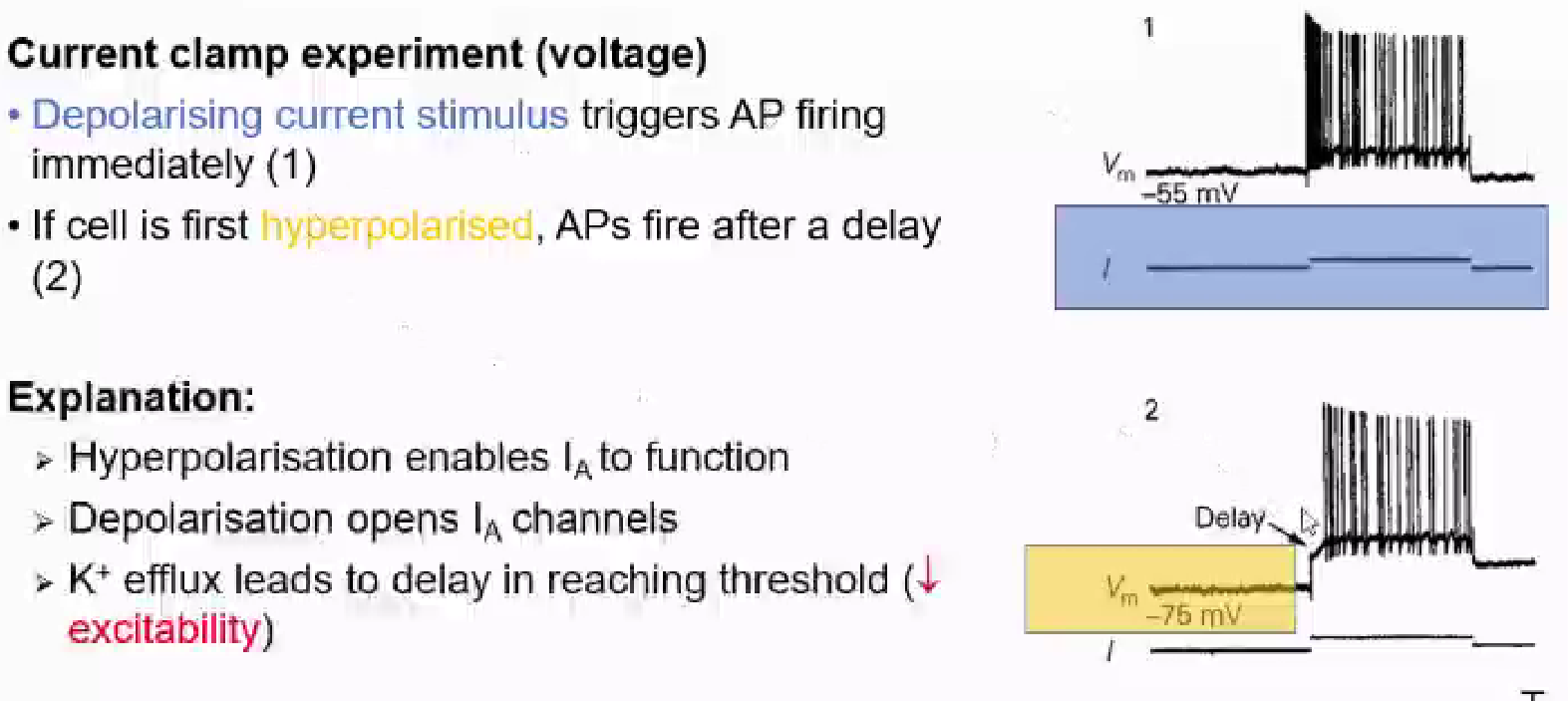Voltage gated ion channels
1/31
There's no tags or description
Looks like no tags are added yet.
Name | Mastery | Learn | Test | Matching | Spaced |
|---|
No study sessions yet.
32 Terms
Outline resting state (from Y1)
At resting membrane potential ~70 mV
Inside of cell negatively charged relative to outside
K+ wants out but can’t leave due to electrostatic pressure
Na+ wants in and can go in due to electrostatic pressure
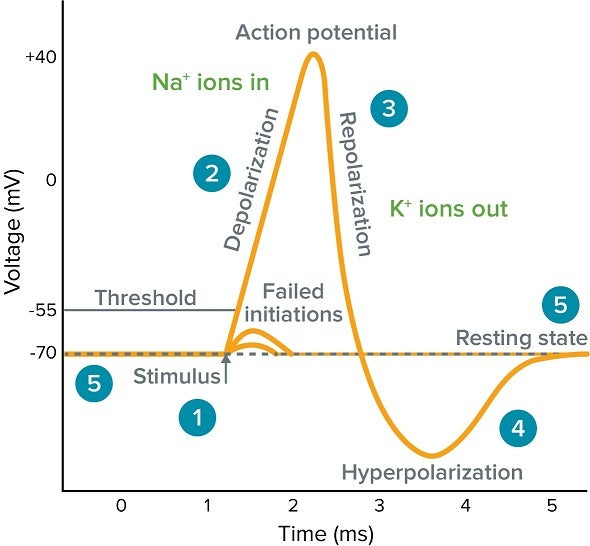
Outline depolarisation (revision from Y1)
Sodium channels open at ~55 mV (threshold of excitation)
sodium floods into neuron (Na+ attracted to -charge inside cell, also going with concentration gradient)
membrane potential grows increasingly positive
potassium channels are open
inside of cell reaches 0, then turns positive
potassium cations leave cell
sodium channels close at +40 mV
potassium channels remain open
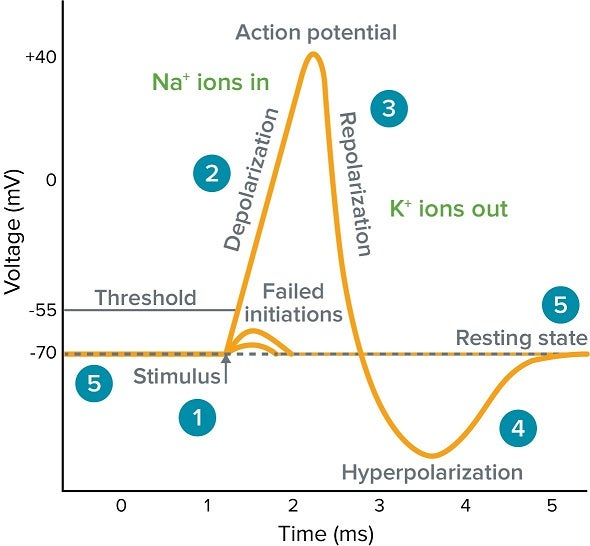
Outline membrane repolarisation + hyperpolarisation (revision from Y1)
potassium channels remain open
potassium cations leave cell due to electrostatic pressure + concentration gradient
even after membrane repolarised, potassium wants to leave, membrane hyperpolarises to lower than -70 mV
potassium channels close after elapsed period, return to RMP
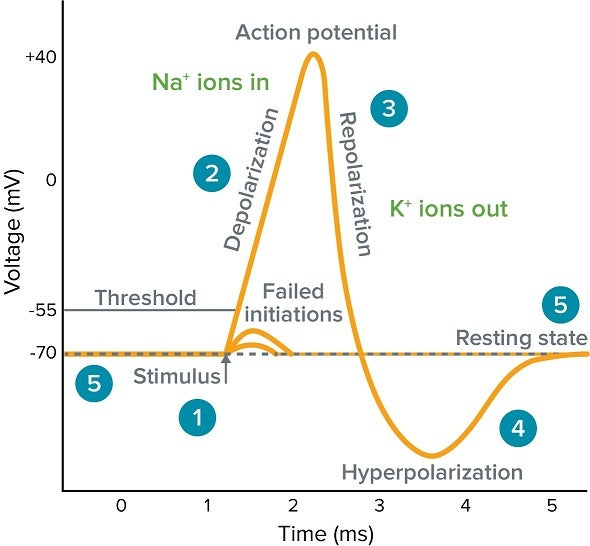
give an overview of voltage gated ion channels
open in response to change in plasma membrane voltage
Activation is voltage and time dependent
some channels close whilst voltage still present, some stay open
transient vs persistent (persistent = staying open while voltage persists, transient = closing when voltage still present)
different channels selective to different ions (cations vs anions)
What is kinetics in the context of voltage gated ion channels?
how fast to channels open when they get a voltage signa?
how fast do channels close, if at all?
outline the structure of voltage gated sodium and calcium channels
channel forms single polypeptide- alpha subunit
4 domains I-IV
domains arranging to form pore
domains contain 6 alpha helices
regulatory beta subunits affect rate of act/inactivation
similar across molecule type
4th alpha helices = voltage sensor (S4 segment)
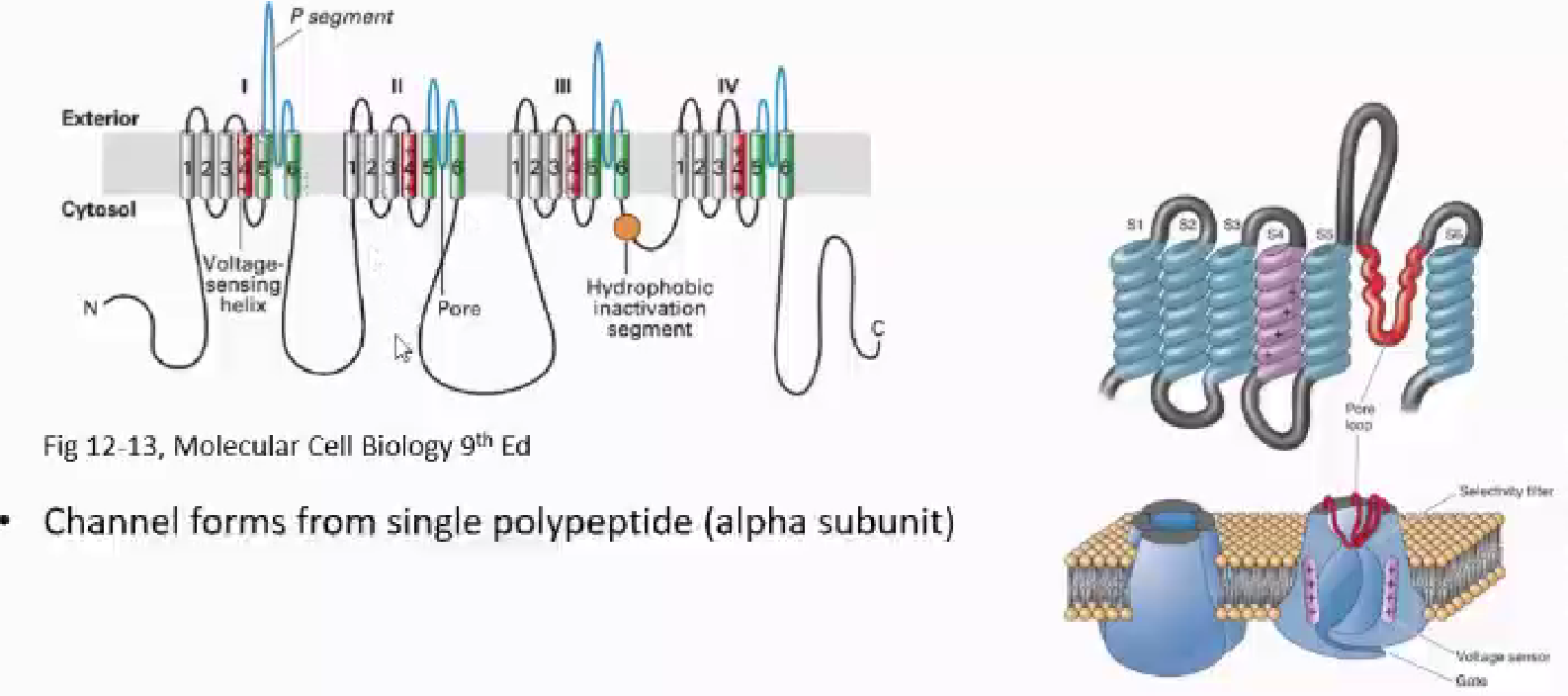
outline the activation of Na channels
S4 segment contains +ve charged AA residues, positive charge caused by depolarisation interacts w/S4 segment + like repels like
depolarisation causes S4 to move outward
conformational change opens channel pore
channel can then conduct + move ions it’s selective for
rapid activation

outline the inactivation of Na channels
Inactivation sequence: ball hanging off end of terminus
inactivation sequence swings into pore + blocks channel
even with voltage signal (during depolarisation), current not passing through channel due to this blockage
allows for Na channels to inactivate very quickly

outline unidirectionality
AP travels in one direction, left —> right from the site of initiation (close to the cell body)
presynaptic cells activate postsynaptic cells- no back propogation causing signals to go back towards where they emanated from
how does the inactivation of sodium channels govern unidirectional conduction?
for a period of time after channels activated, sodium channels remain inactive due to channel block
during this period, channels are refractory and can no longer depolarise
this refractory period means the AP cannot back propagate and ensures unidirectionality
outline the structure of potassium channels
similar to Na channels EXCEPT: not a single polypeptide. Instead, 4 separate subunits forming a tetramer
each subunit has 6 alpha helices
Some K+ channels don’t inactivate- unlike sodium channels
For K+ channels that do activate, 4 N terminal inactivation segments, 1 for each subunit
1 inactivation segment can inactivate the channel
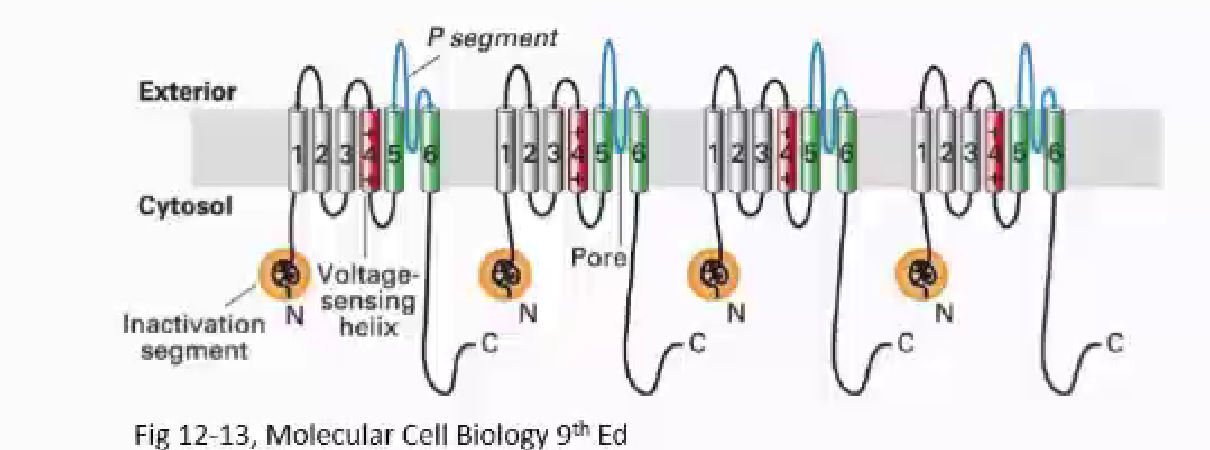
How to voltage gated conductances drive the action potential?
High densities of Na+ channels at the axon initial segment + nodes of Ranvier
Voltage dependent activation ~ -55mV
Na+ current flows into cell generating upstroke of AP
Potassium lags behind sodium, channels open slower, slower kinetics
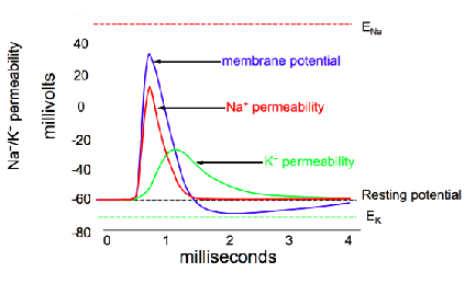
Outline how the delayed K+ current repolarises membrane potential after the AP
K+ channels clustered next to nodes (juxtaparanodes)
Voltage gated K+ channels open around 1ms after Na+ channels
membrane permeability to K+ increases
K+ ions move out across the membrane
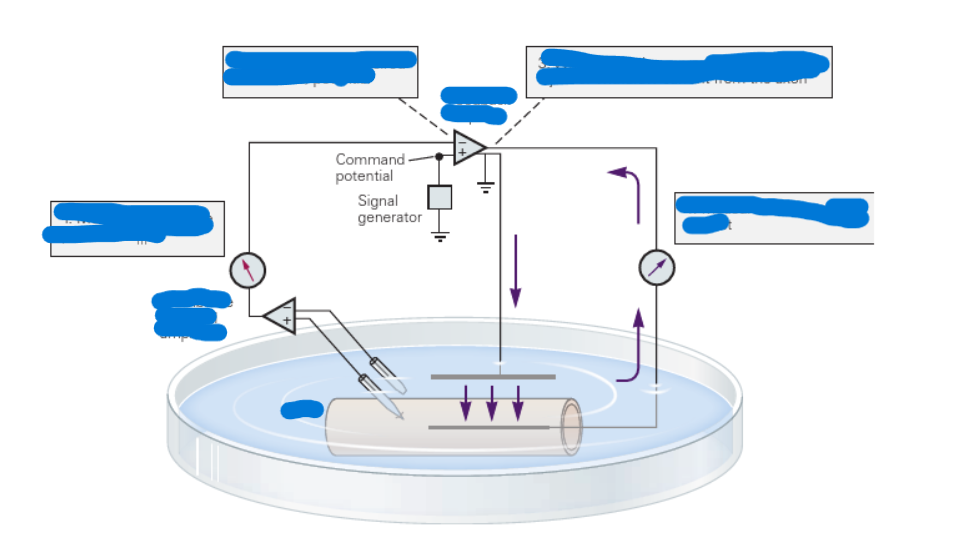
Label and talk through this diagram
This is a voltage clamp used to analyse ion channel function
The whole thing is a feedback circuit
We are recording voltage based on the reference electrode in the extracellular fluid and the recording electrode in the axon, as voltage is a potential difference
The dish has salt solutions replicating the ionic solution in animals’ nervous systems
We set the desired voltage at any voltage we like, then record the voltage to see which current we need to clamp our membrane at that voltage


Give a step-by-step run through of how voltage clamps work
set voltage into feedback amplifier
recording voltage of axon with membrane potential amplifier
this voltage is sent to feedback amplifier
feedback amplifier compares recorded voltage to desired voltage
if there’s a difference, feedback amplifier sends signal to send positive current into axon to try and depolarise it (compensatory current)
change in voltage read by first amplifier, feeds back to feedback amplifier
repeat until both amplifiers read same voltage
once amplifiers read same voltage- equilibrium, get a steady state current that is noted down
measuring current required to reach one voltage is not the end of a voltage clamp experiment

why do we do voltage clamps?
voltage clamp activates VG ion channels
Current flow through the channels can be detected
we can explore what happens when we change voltage
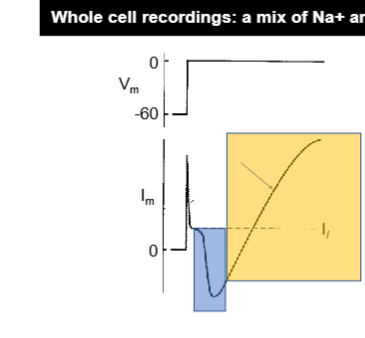
Walk through this whole cell recording
At the top- Vm = voltage clamp, clamped at 60 then membrane potential (depolarisation) to 0
Im = membrane current, in this case compensatory current
the waveform is in response of voltage gated channels
yellow = potassium channel: going in positive deflection (upward, positive current) = potassium efflux- notice the lag
blue = sodium channels: going in negative deflection (downwards, negative current) = sodium influx
voltage clamp recordings are mirror opposite of what the cell is experiencing, as we are looking at the current compensating for what is occurring in channels
why are sodium currents always a downward waveform and potassium currents always an upward waveform?
Na: voltage clamp compensating to + charge caused by influx of sodium ions by injecting - charge
K: voltage clamp compensating to - charge caused by efflux of K ions by injecting + charge
how can we isolate channel currents through pharmacology?
Tetrotodoxin (TTX) = sodium channel blocker, allows for isolation of potassium current
Tetraethylammonium (TEA) = potassium channel blocker, allows for isolation of sodium current
allow us to see current kinetics w/out contamination from other channel functions
what do we see when we isolate K+ and Na+ currents through blockers?
K+ channels = slower opening, do not inactivate
Na+ channels = fast opening, inactivate

What does I stand for?
current: Im = membrane current, INa = sodium current, etc
what does V stand for?
Voltage- Vm = membrane voltage, VNa = sodium voltage, etc
What are families of voltage-clamp steps?
When we change the voltage up and down in steps, progressively increasing the depolarisation of the voltage clamp
Allows us to activate ion channels and see how much current flows through ion channels at different voltages
persistent currents = currents that remain until voltage turned off

Walk through this K+ current family
Linear response- the more depolarised we get, the greater the current becomes
Voltage plot: current in response to voltage, measure peak current at each voltage step and plot it
Ek at -80: equilibrium potential for K+: depolarisation and driving force directly balanced, zero current flow
Driving force increases as we depolarise, larger membrane current
outline how driving force relates to equilibrium potential
Driving force = Vm - Ek
Driving force = membrane potential - equilibrium potential
driving force determines membrane current, regulates how much current we can record
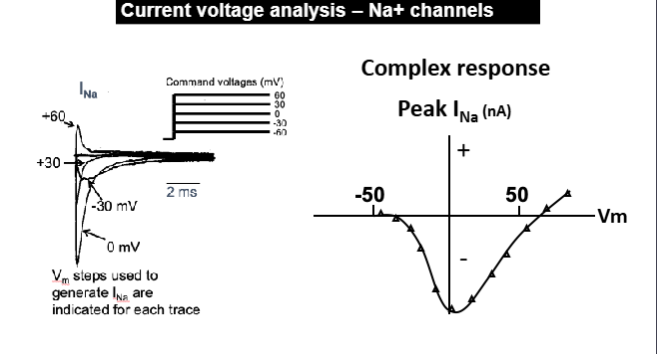
walk through this Na+ current family
Immediately see that it’s more complex than K+ channel familiies
-60 = no current
Downward current at -30
peak at 0
reduction at +3-
reversal to upward deflection at +60: current leaving cell
this is ENa - opposite end of spectrum to potassium
biphasic response: current increases as we depolarise to a plateau, current then reduces to a point, then reverses over that
driving force diminishes as we get closer to the equilibrium potential
reduction in membrane current = due to decrease in driving force, not channels closing
Ina reduces as driving force decreases
How do we measure channel conductance?
AKA ‘g’
Indirectly through membrane current- we can’t measure it experimentally
Conductance = membrane current/driving force
Example with potassium conductance:
gK = Ik / (Vm - EK)
potassium conductance = membrane current / (membrane potential - equilibrium potential)
How can we rearrange hodgkin and huxley’s equation for calculating current?
for potassium:
IK = gK(Vm-EK) (membrane current = conductance x driving force)
Ik should be zero at EK
As driving force decreases, no matter how big gK is, if you keep reducing driving force, membrane currents get smaller even if channels open
outline the difference between current and conductance
Linked in that one depends on the other: gate + passenger analogy
Conductance is gates, current is passengers through gates
Conductance = gates open, passengers can get through (ions)
Gates closed = no conductance, no passengers getting through (resting membrane)
Conductance can never be less than 0: all gates closed, cannot have less than 0 gates closed
Membrane current can occupy + or - values, conductance can only be positive
No current without conductance, but yes conductance without current- cannot have passengers passing through gates without gates being open, but gates =/= open in response to passengers waiting
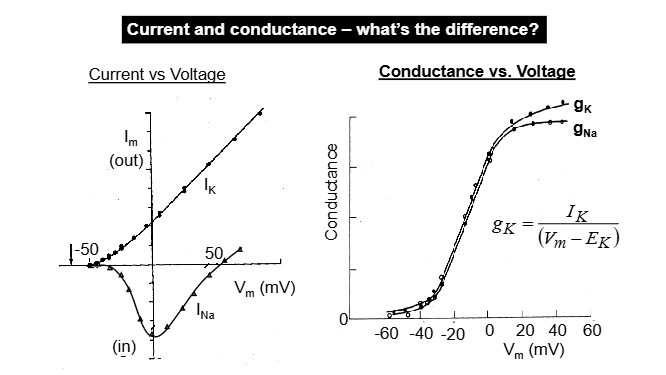
Outline A type potassium channels
Regulate neuronal activity beyond repolarisation
Control onset (how soon after) and frequency of firing of APs
conduct K+ (efflux)- reduce excitability of neurons
Voltage-gated
Activate quickly unlike delayed rectifier
Inactivate (like Ina, unlike delayed rectifier)
outline the in/activation of A-type K+ channels
AKA IA
at RMP = mostly inactivated
Inactivation removed by hyperpolarisation
react instantaneously
activate then deactivate quickly

Outline how A type potassium channels delay the initiation of AP firing
neuron is sat at whatever MP it wants, current passed to depolarise it, triggers train of AP fires at such a high frequency that at first you can’t distinguish APs
briefly hyperpolarising the same neuron before depolarising it = lag before it fires
delay looks small but matters a lot at level of circuit function
delaying firing = functional consequences across the circuit
delay caused by the fact that we have IA in cell
neuron depolarises, IAs open, rapid efflux of K+ causes slight negative balance against depolarisation, for a while depolarisation is happening while there is an outflow of K+
IA channels help delay firing in the neuron
